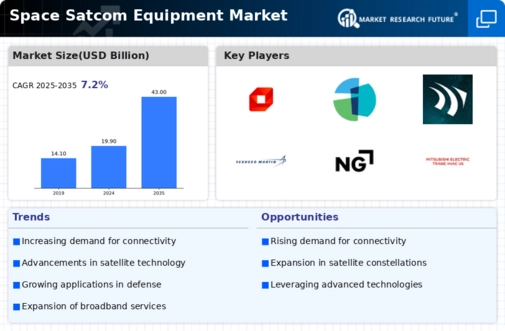The Space Satcom Equipment Market is characterized by a rapidly evolving landscape marked by technological advancements and growing demand for satellite communication services. The competitive dynamics within this market are influenced by several factors including innovation, strategic partnerships, and the ability to meet the diverse needs of customers across different regions.
As companies strive to maintain their market positions, they are focusing on enhancing operational efficiencies and expanding their product offerings to cater to a wide array of applications, including broadband services, government communications, and broadcasting.
With the increasing emphasis on satellite-based connectivity and the expansion of satellite constellations, the competitive environment in the Space Satcom Equipment Market remains robust, highlighting the importance of adaptation and foresight in developing successful strategies.
Telesat has established a significant presence in the Space Satcom Equipment Market through its commitment to innovation and high-quality service delivery. The company leverages its extensive experience in satellite operations to offer reliable and advanced satcom solutions that cater to a variety of sectors including telecommunications, media, and broadband services.
Telesat's strengths lie in its ability to provide low-latency communications and scalable solutions that meet the evolving demands of customers. Furthermore, the company's strategic initiatives to enhance its satellite fleet, including the development of next-generation satellites, bolster its competitive edge and enhance its market positioning.
Telesat's focus on customer-centric solutions and strategic partnerships fosters a robust ecosystem that supports the growing demand for satellite communication, allowing the company to maintain a strong foothold in the industry.
Intelsat has emerged as a formidable player in the Space Satcom Equipment Market, driven by its extensive experience and strong operational capabilities. The company is well-positioned to serve a broad range of clients with its advanced satellite communication technologies and robust service offerings.
Intelsat's strength lies in its operational excellence, which is reflected in its ability to deliver high-quality satellite services across various sectors, including fixed broadband, mobility, and government applications.
The company is recognized for its extensive satellite network, which provides comprehensive coverage and enhanced reliability for its customers. Moreover, Intelsat actively invests in upgrading its satellite infrastructure and exploring innovative solutions to meet the growing demand for connectivity.
This commitment to technological advancement ensures that Intelsat remains competitive in the ever-changing satcom landscape, positioning the company as a key player in providing critical communication solutions worldwide.














